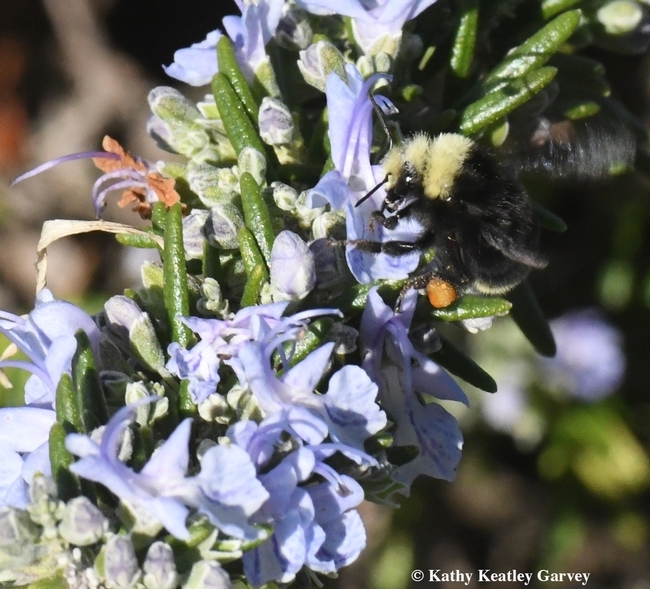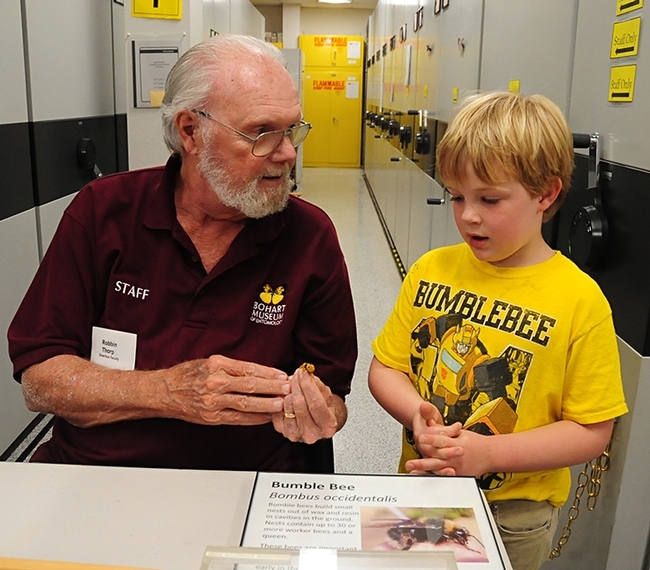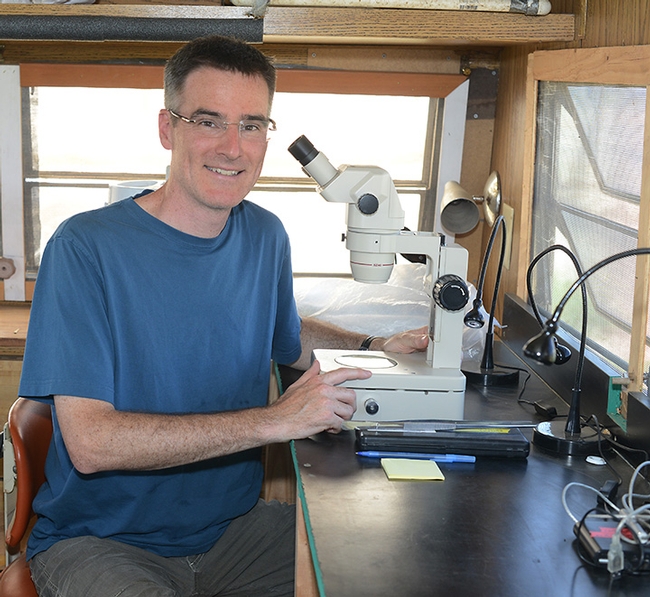- Author: Kathy Keatley Garvey
She was all bees-ness, this yellow-faced queen bumble bee, Bombus vosnesenskii.
There she was, foraging in a bed of steely blue-purple flowers, Eryngium amethystinum, a genus that belongs to the carrot family, Apiaceae.
A native bee on a non-native plant.
It was Saturday, Nov. 19 and the temperature hovered at a unseasonable 64 degrees in the Sunset Gardens, Sonoma Cornerstone, Sonoma, Calif.
Unseasonable weather and an unseasonable bumble bee.
B. vosnesenskii are spring bees, and this time of year, the queen is usually hibernating, according to the late Robbin Thorp (1933-2019), UC Davis distinguished emeritus professor of entomology and a global authority on bees. In his retirement, he co-authored Bumble Bees of North America: An Identification Guide (Princeton University, 2014) and California Bees and Blooms: A Guide for Gardeners and Naturalists (Heyday, 2014).
“Bumble bees provide an important ecological service--pollination," he told us several years before his passing. "This service is critical to reproduction of a huge diversity of plants that in turn provide shelter, food (seeds, fruits) to diverse wildlife. The potential cascade of effects from the removal of even one localized pollinator may affect us directly and indirectly.”
Professor Thorp would have loved to see this bumble bee in Sonoma. He also would have loved to know that the Bohart Museum of Entomology at UC Davis launched the annual Robbin Thorp Memorial First-Bumble-Bee-of-the-Year Contest in 2021.
Contest coordinator Lynn Kimsey, director of the Bohart Museum and a UC Davis distinguished professor of entomology, seeks the first bumble bee of the year in the two-county area of Yolo or Solano. The rules are simple: photograph it, record the time and date, and email the image to the Bohart Museum at bmuseum@ucdavis.edu.
Coincidentally, this year UC Davis doctoral candidate Maureen Page of the Neal Williams lab, UC Davis Department of Entomology and Nematology and horticulturist Ellen Zagory, retired director of public horticulture for the UC Davis Arboretum and Public Garden each took their images at exactly 2:30 p.m. on Jan. 1 in the Arboretum to share the award.
Page captured her image of B. melanopygus, considered the earliest Bombus species to emerge in this area, and Zagory, of B. vosnesenskii. (See Jan. 3, 2022 Bug Squad blog)
And fittingly, they both knew and worked with Professor Thorp.
Their prize? Each receive a coffee cup designed with the endangered Franklin's bumble bee, a bee that Thorp closely monitored in its small range at the California-Oregon border. The cup features an image of a bee specimen, photographed by Bohart scientist Brennen Dyer, and designed by UC Davis doctoral alumnus Fran Keller, professor at Folsom Lake College.
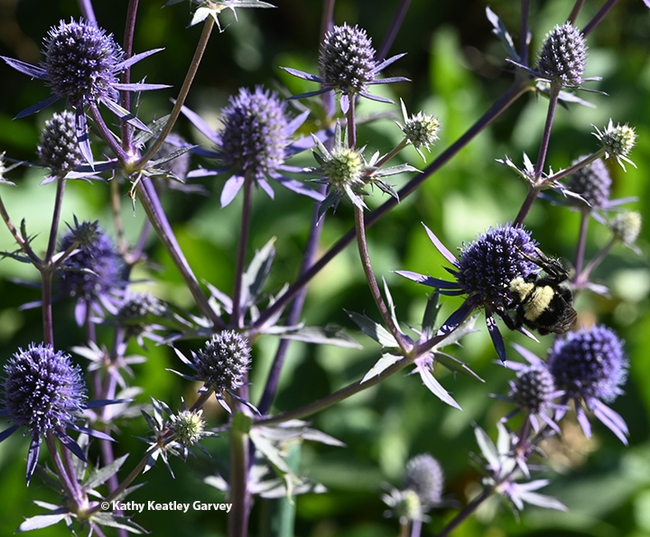
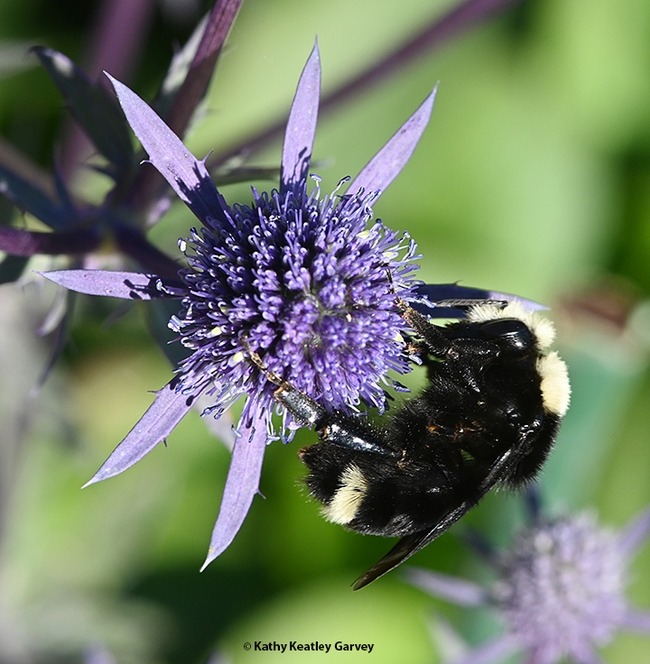
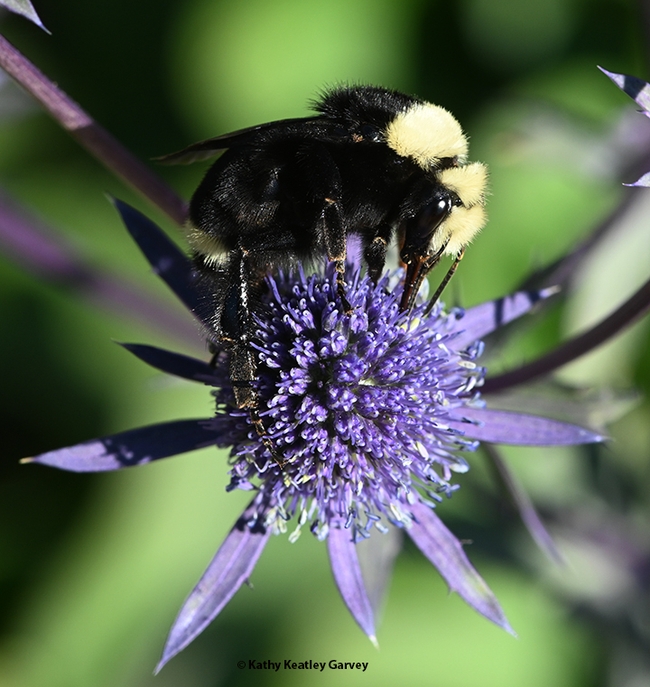
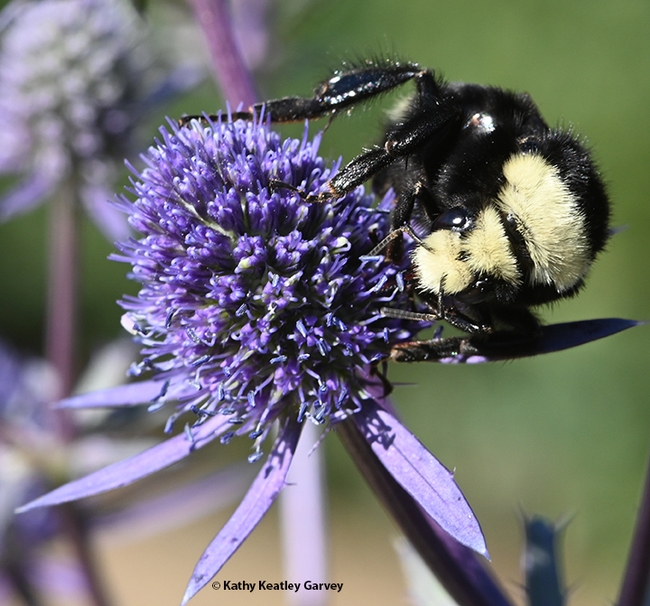
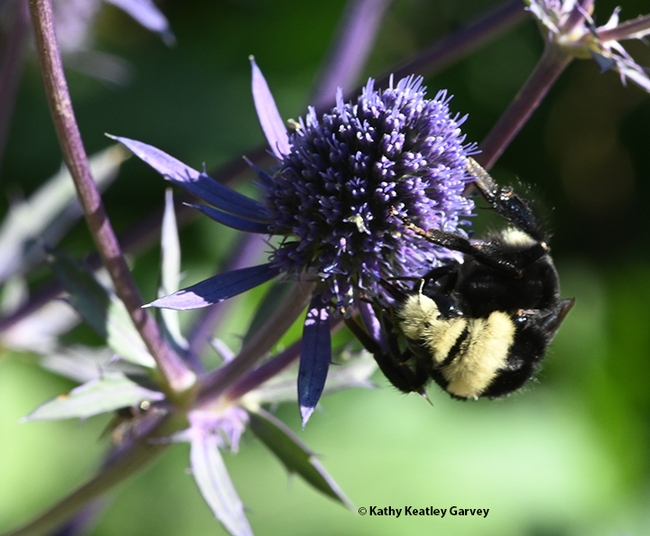
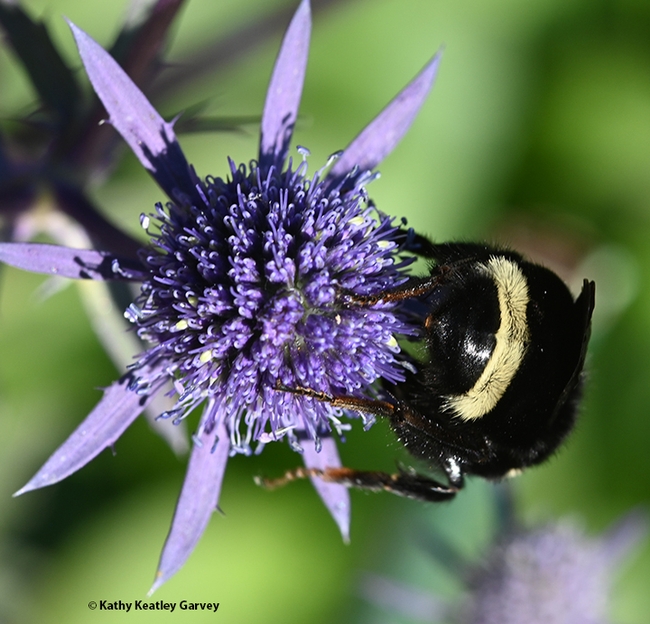
- Author: Kathy Keatley Garvey
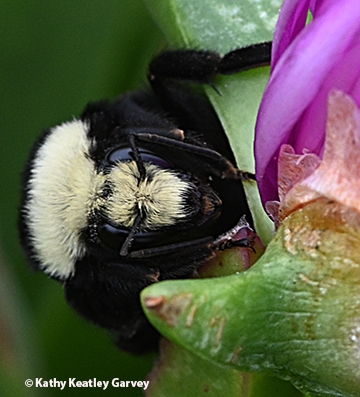
The yellow-faced bumble bee bursts from a neon pink blossom in the video below.
It's Oct. 19, 2022 and the temperature has soared to an unseasonal 81 degrees. This bumble bee is hungry. She may have emerged from hibernation "to get a bite to eat," as the late Robbin Thorp, UC Davis distinguished emeritus professor of entomology, used to say about late-in-the-season sightings.
B. vosenenskii, native to the west coast of North America, from Baja California to British Columbia, is an important pollinator, especially important for its buzz pollination of tomatoes, peppers and cranberries. In buzz pollination, the bumble bees grab a blossom and shake it, dislodging the pollen to accomplish pollination.
The ice plant, Carpobrotus edulis, is a native of South Africa and known as an invasive weed.
Interesting that on one end of the Doran Regional Park, volunteers with the California Native Plant Society are pulling out the ice plant to make room for native plants, while on the other end, a bumble bee hungrily sips the nectar. "Ice plant chokes out native plants and alters the local soil composition," according to the park website. "Removing ice plant allows native, endangered plants to repopulate the area and wildlife to thrive."
Want to learn more about the bumble bees around us? Read these two books, both co-authored by Thorp in his retirement: Bumble Bees of North America: An Identification Guide (Princeton University, 2014) and California Bees and Blooms: A Guide for Gardeners and Naturalists (Heyday, 2014).
And, if you see a bumble bee and would like to get involved in citizen science, Bumble Bee Watch seeks your sightings.
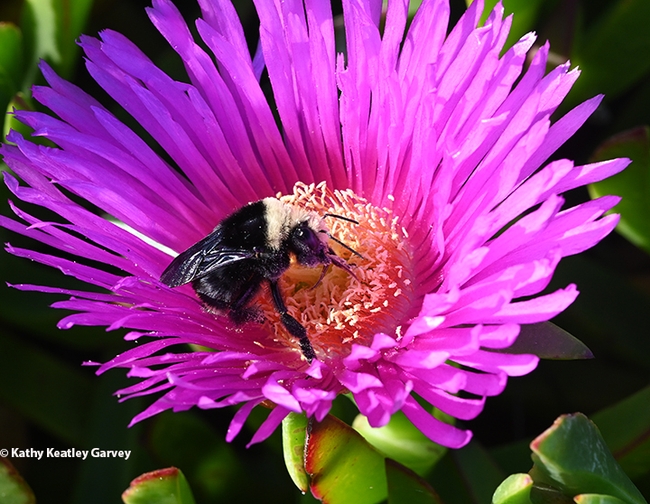
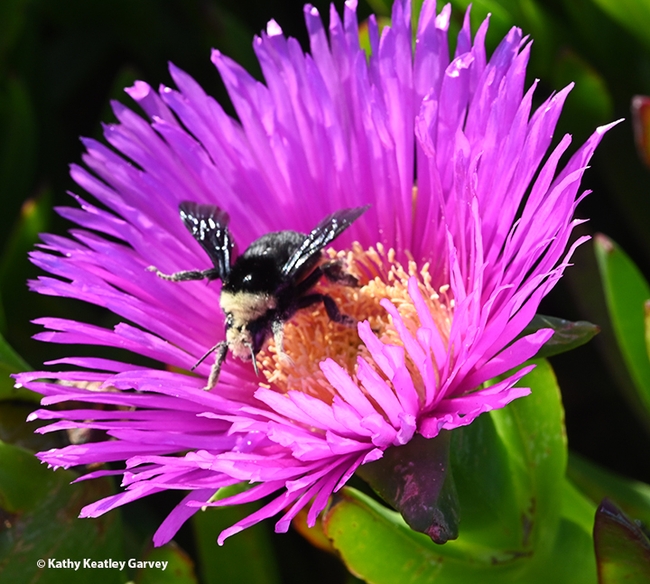
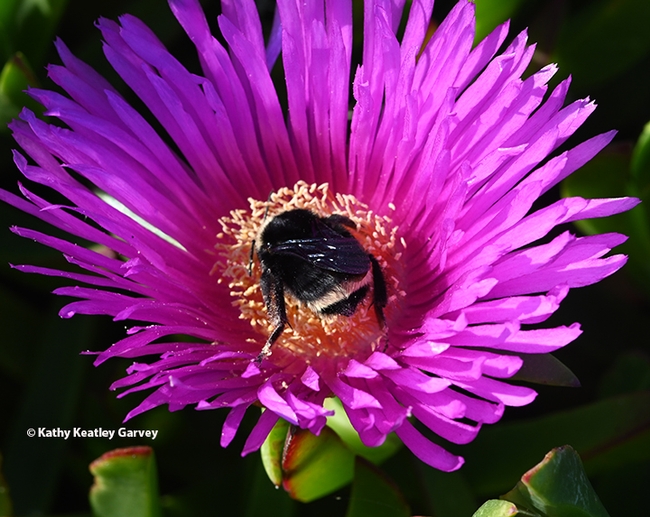
- Author: Kathy Keatley Garvey
The highly respected California Academy of Sciences greeted its 2019 Class of Fellows on Oct. 15, and one of them is a pollination ecologist from the University of California, Davis.
Professor Neal Williams of the UC Davis Department of Entomology and Nematology was inducted into the scientific organization at the annual Bay Area gathering of the Fellows. The group includes more than 450 distinguished scientists who have made notable contributions to science.
Dermatologist and associate professor Emanual Michael Maverakis of UC Davis Health was among the 13 other Fellows. (See list of 2019 inductees)
Fellows nominate others for the high honor, and then the California Academy of Sciences' Board of Trustees votes on the nominees. James R. Carey, distinguished professor of entomology, nominated Williams, with Claire Kremen of the University of British Columbia, formerly of UC Berkeley, seconding the nomination. Maverakis was nominated by Walter Leal, distinguished professor, UC Davis Department of Molecular and Cellular Biology, and a former chair of the entomology department.
In his letter of nomination, Carey wrote that Williams is “widely known and respected for his excellence in research, extension, outreach, teaching and leadership” and “is not only one of the stars of our campus, and the UC system, but is an internationally recognized leader in pollination and bee biology and strong voice in the development of collaborative research on insect ecology. He has organized national and international conferences, leads scores of working groups, and guides reviews of impacts of land use and other global change drivers on insects and the ecosystem services they provide.”
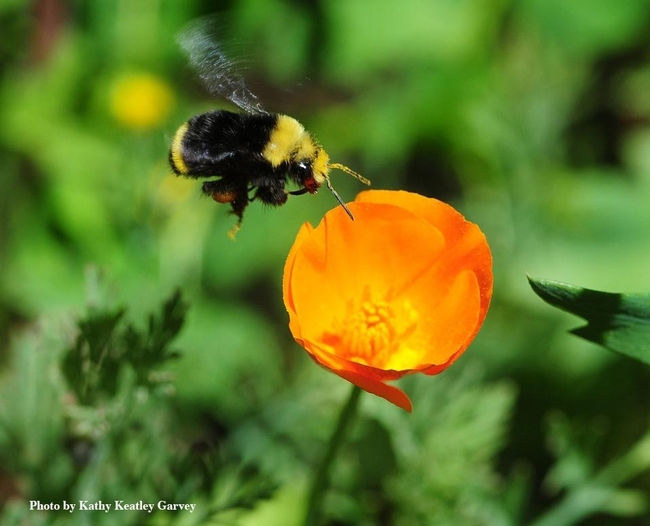
The UC Davis professor served as co-chair (with Extension apiclturist Elina Lastro Niño) of the seventh annual International Pollinator Conference, a four-day conference held July 17-20 on the UC Davis campus. The global conference focused on pollinator biology health and policy.
In his work--a labor of love--Williams seeks and finds found common solutions for sustaining both wild and managed bees and communicates that information to the public and stakeholder groups. Said Carey: “This is a critical perspective in natural and agricultural lands, but also in urban landscapes in northern and southern California.”
Each year the UC Davis professor speaks to multiple beekeeper, farmer and gardener groups, and provides guidance to governing bodies, including the state legislature, and environmental groups. He and his lab are involved in a newly initiated California Bombus assessment project, which is using both museum and citizen scientist records to understand past, current and future distributions and habitat use by bumble bees. This program will host a series of workshops this spring and summer open to practitioners and the public.
Williams received his doctorate in ecology and evolution in 1999 from the State University of New York, Stony Brook and served as an assistant professor in the Department of Biology at Bryn Mawr (Penn.) College from 2004 to 2009. He joined the UC Davis faculty in 2009, advancing to full professor in 2017.
His honors and awards are numerous. Williams was part of the UC Davis Bee Team that won the Team Research Award from the Pacific Branch, Entomological Society of America (PBESA) in 2013. In 2015, he was named a five-year Chancellor's Fellow, receiving $25,000 to support his research, teaching and public service activities. And then earlier this year, Williams received PBESA's Plant-Insect Ecosystems Award, presented annually for outstanding accomplishments in the study of insect interrelationships with plants.
In addition to Carey, five others affiliated with UC Davis Department of Entomology and Nematology are Fellows of the California Academy of Sciences:
- Professor Phil Ward, ant specialist
- Frank Zalom, integrated pest management specialist and distinguished professor of entomology. He is a past president of the Entomological Society of America
- Robert E. Page Jr., bee scientist and UC Davis distinguished emeritus professor. He is a former chair of the UC Davis Department of Entomology and provost emeritus of Arizona State University
- Walter Leal, distinguished professor, UC Davis Department of Molecular and Cellular Biology, and a former chair of the entomology department; and
- Visiting scientist Catherine Tauber, formerly of Cornell University.
Former Fellows from the UC Davis entomology department include Robbin Thorp (1933-2019), distinguished emeritus professor of entomology, and visiting scientist Maurice Tauber (1931-2014), formerly of Cornell University.
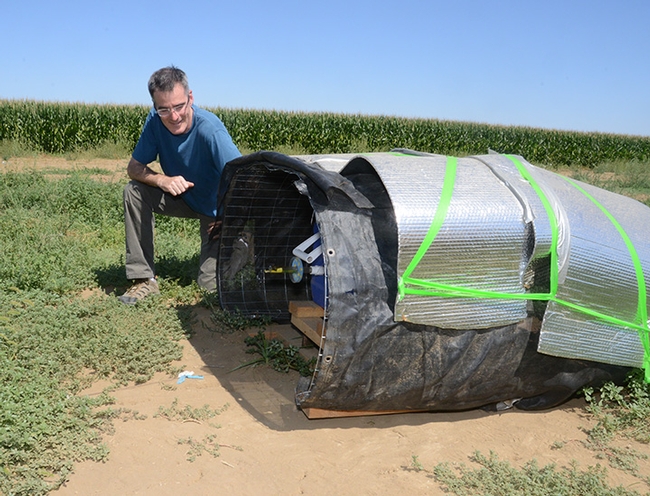
- Author: Kathy Keatley Garvey
Remember receiving valentine cards that read "Bee My Valentine?"
Well, every day can be Valentine's Day when there are bees in your garden.
We captured this image several years ago of a queen bumble bee, Bombus vosnesenskii, nectaring on a spiked floral purple plant, Salvia indigo spires (Salvia farinacea x S. farinacea). She had just emerged from her winter hibernation on a sunny day in November. The site: the Sonoma Cornerstone pollinator garden of Kate Frey. She's the co-author of The Bee-Friendly Garden (with UC San Francisco professor Gretchen LeBuhn), and a world-class garden designer and pollinator advocate.
It wasn't Valentine's Day, but then again, yes, it was!
Every day is Valentine's Day when there are bees in your garden.
Bee my valentine!
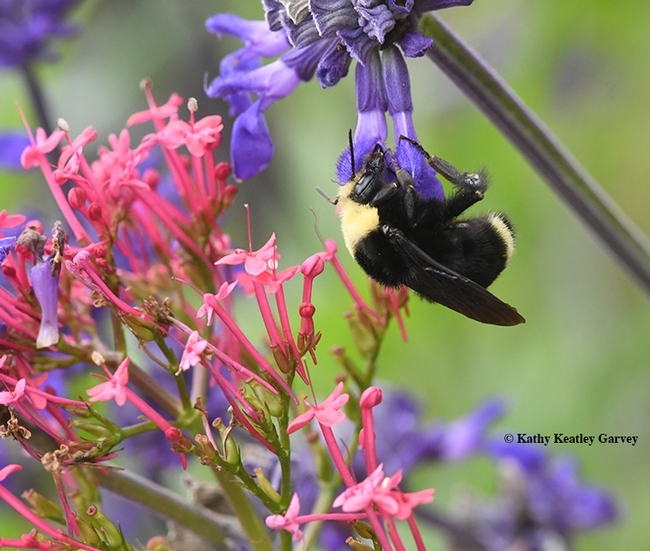
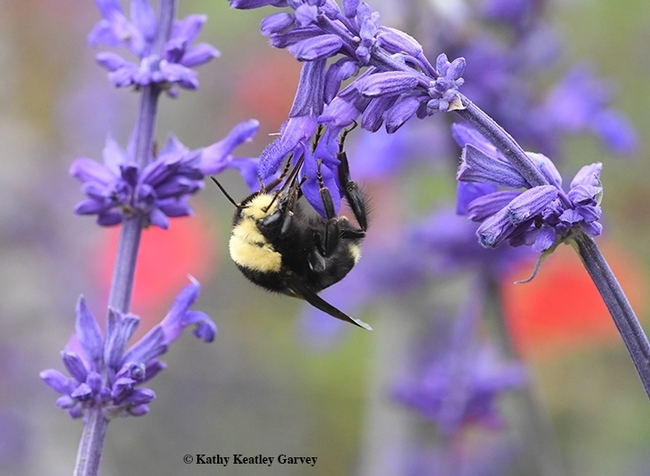
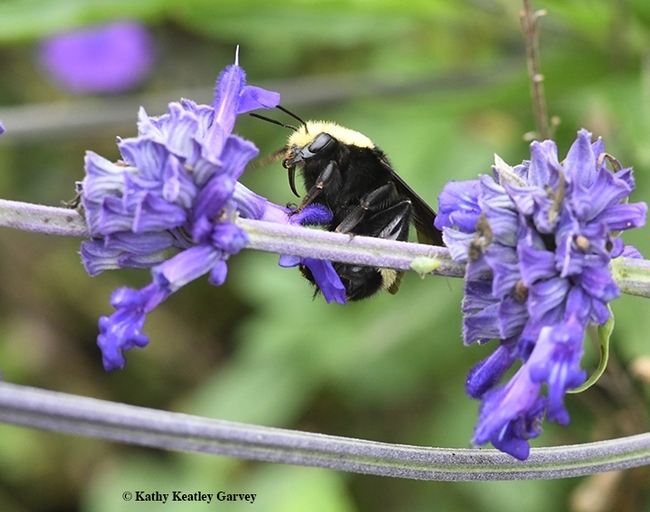
- Author: Kathy Keatley Garvey
It was the morning of Jan. 1, 2018, a year and four days ago.
While strolling the grounds of the Benicia Capitol State Historic Park, we captured images of yellow-faced bumble bees, Bombus vosnesenskii, nectaring on jade, Crassula ovata. They were packing cream-colored pollen from the jade. The same day, we spotted the same species nectaring on rosemary, Rosmarinus officinalis, by the Benicia marina, but packing orange pollen, probably from the nearby California golden poppies.
Thus began our Year of the Insects.
So far this year, we haven't spotted a single bumble bee in Solano or Yolo counties. It's too early in the season (except for hot spots in Benicia, Solano County, where even some almond trees bloom on Jan. 1!)
Nowadays, though, the talk isn't just about "bumble Bees," the insect, but "Bumblebee," the movie, as in the 2018 American science fiction action film. It's about a Transformers' character of the same name, described as "battle-scarred and broken."
Why is the insect spelled "bumble bee," two words? The Entomological Association of America (ESA), in its newsletter, Entomology Today, explains: "...entomologists use two words if a common name accurately describes the order to which a particular insect belongs. For example, all true flies belong to the order Diptera, so true fly names will be spelled using two words by entomologists--house fly, horse fly, pigeon fly, or stable fly, for example. However, despite their names, dragonflies and butterflies are NOT true flies --their orders are Odonata and Lepidoptera, respectively — so they are spelled as one word." (Check out the ESA Comman Names of Insects Database.)
So there you have it: bumble bee, the insect, and Bumblebee, the movie.
And sometimes there's a serendipity moment when the two meet.
We remember back in April of 2017 when native pollinator specialist Robbin Thorp, distinguished emeritus professor of entomology, UC Davis Department of Nematology and Nematology, was displaying bumble bees at a Bohart Museum of Entomology open house.
Thorp, a global authority on bumble bees, is the author of Bumble Bees of North America: an Identification Guide (Princeton University) and California Bees and Blooms: A Guide for Gardeners and Naturalists (Heyday).
So was he ever surprised when in a defining moment, 6-year-old Adne Burruss of Irvine (his mother, Sigrid, is a geneticist and UC Davis alumna) walked up to him wearing a Bumblebee t-shirt. Adne wanted to look at the "other" bumble bees.
So do we! So do we!
